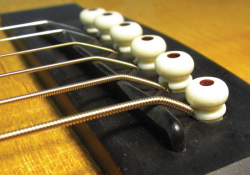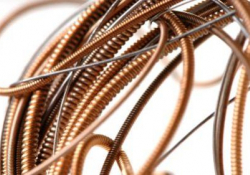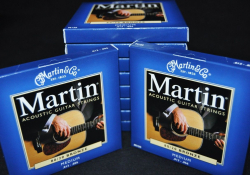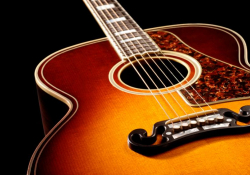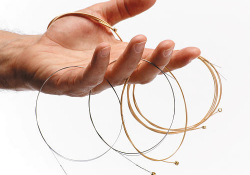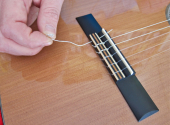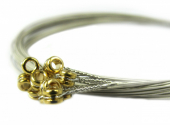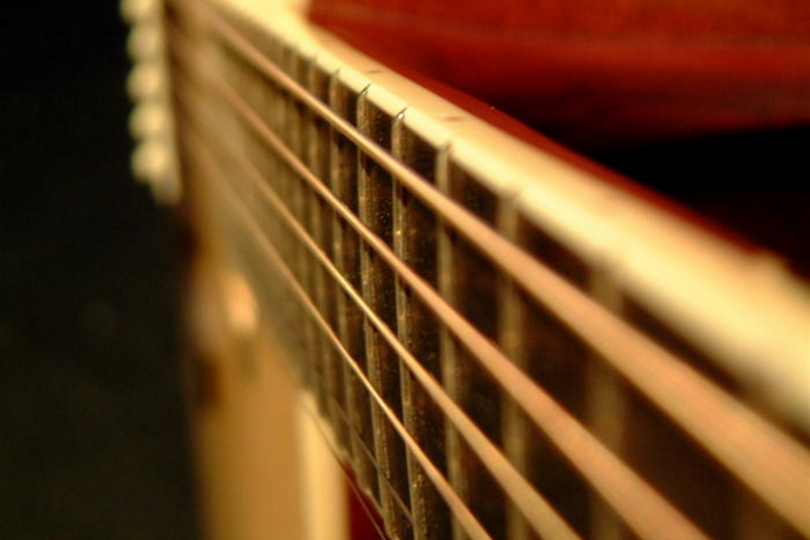
How To Choose Strings for Steel-String Acoustic Guitar
In the first part of our guide to choosing guitar strings, we focused on classical guitar, which inherently includes nylon strings. Today we will discuss strings designed for dreadnought, jumbo, etc. guitars. That is to say, steel-string acoustic guitars. What exactly are steel strings and how to choose them correctly?
Steel strings
Steel strings first appeared on acoustic guitars around 1900. Since then, their use has basically stayed the same, only the technology of their manufacture has changed. As a rule, they consist of a steel core and a winding. The winding is always made of a softer material than the core (usually bronze or phosphor bronze), which can be either circular or hexagonal in profile.
Some manufacturers claim that the hexagonal core lasts longer, or that the round core gives the tone that true "vintage" sound. But the reality is rather that all strings last for about the same amount of time, and their lifespan depends mostly on how we take care of them and also on how much we "cut" into them. But of course there is a difference.
The production of round core strings is much more expensive as they are often wound in a nice "old fashioned" manual way, so a musician who gets such strings may feel that they sound "old." On the other hand, hexagonal core strings are made using modern technology and the winding of these strings is much more stable, as the edges of the core "bite" into the wrapping of softer materials. This creates a solid connection and improves intonation. Of course, only wound strings have a hexagonal core. The e and h strings are always round, no exceptions.
String windings can be divided into three basic categories: Round Wound, which is the most common; Half Round Wound; and Flat Wound. The Round Wound has a clear and penetrating sound, while the Half Round Wound has a warmer sound and reduces the sometimes unwanted clacking that occurs when moving between positions on the strings. Flat Wounds are very popular among blues and jazz players. Their sound is darker and evokes the "vintage" sound of the 50s and 60s.
Coated strings constitute a specific group of steel strings for acoustic guitar. These are strings that are coated with a protective coating that prevents them from having their lifespan reduced by getting dirty. A typical example of such protection is the PolyWeb or NanoWeb technology used by Elixir. However, several other manufacturers (e.g. Martin or DR Strings) use similar string protection systems.
The coating of these strings can be compared to a kind of "bubble wrap," though only a few microns thick. This coating does not limit the vibration of the string and does not have any significant effect on its sound properties. Moreover, this layer again reduces clacking noises when changing the position of the hand, while the string retains more or less its natural smoothness. Such strings cost more to purchase, but their lifetime is several times longer than that of conventional strings.
So which strings to choose?
Choosing a type of strings
First of all, your choice should be based on the type of guitar. In general, dreadnought and jumbo guitars have a thicker soundboard, which can take more tension while needing a bit more energy to make it sound good. This means that you should use strings at least .011 to .013 thick. On the other hand, smaller-bodied guitars such as GC, GO, GS, folk, and parlor have thinner soundboards, lighter internal ribbing, and often a shorter gauge. The most suitable strings for these types of guitars are .010 to .011 gauge, but you can check the manufacturer's website or ask them directly if thicker strings are appropriate for your particular model. It is also always advisable to think about the correct neck tension when using strings of a higher gauge, even when using so-called alternative tunings.
It also goes that the thicker the strings, the denser and louder the sound, and the more the strings will stay in tune, but at the cost of being more difficult to play. It is also true that thick strings are not quite suitable for fingerstyle or more technically demanding playing. Thinner strings (.009 or .010), on the other hand, are especially suitable for beginners, but only for a limited time until the fingers get used to it, as thin strings do not have enough mass and energy to sound the top plate and the resulting sound is bland and constrained, with a predominance of treble and muffled bass tones.
Some manufacturers use a words instead of the traditional .009, .010, .011, etc., when labeling string thickness. Just to give you an idea:
Super Light – equals thickness .009
Extra Light – equals thickness .010
Custom Light – equals thickness .011
Light – equals thickness .012
Medium – equals thickness .013
When choosing a set of strings, try not to choose the thickness only according to the thinnest string in the set, because each manufacturer may use different thicknesses of the other strings and sometimes you may come across sets of strings starting with the same .012 but ending with .053, .054 or even .056.
Maintenance of steel strings
As with nylon strings, the same rule applies here as well: play with dry and clean hands and wipe the strings with a suitable product (GHS Fast Fret, Dunlop, Ernie Ball) or at least with a cloth, cleaning each string individually. When using the product, be careful not to get it on the fingerboard as well, as this is definitely not what string cleaner is for.
Was this article helpful to you? Let us know in the comments below.
If you have found an error or typo in the article, please let us know by e-mail info@insounder.org.

